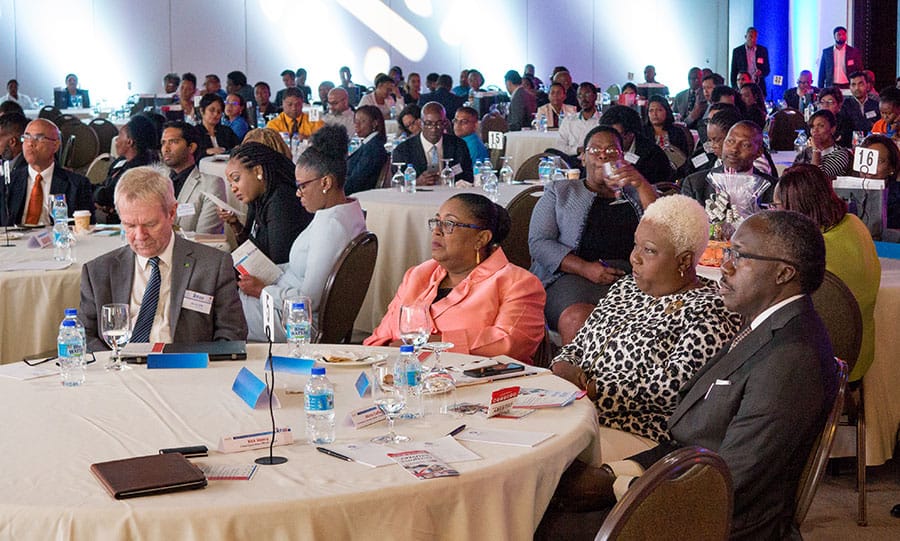
Above: Front table at the symposium, Dr Arvo Ott, Marlene McDonald, Esther Le Gendre and Maxie Cuffie. Photos by Mark Lyndersay
BitDepth#1168 for October 25, 2018.
During Marlene McDonald’s speech at the 2018 ICT Symposium organised by National Information and Communication Technology Company (iGovTT), I had a powerful sense of déjà vu. It turns out that I was correct. I’d lived through that speech before, specifically in 2008, when Kennedy Swaratsingh, also a Minister of Public Administration, spoke at another ICT symposium in that very room.
In all fairness, any speech that effectively begins with the words “The world is changing and it is doing so much more rapidly than before,” isn’t heading into groundbreaking territory.
There seemed to be three kinds of talks happening in the room last Friday morning, promises of great things to come, gun talk from the digital arriviste and hard advice from those with practical experience of what needs to get done.
McDonald spoke of a government that could no longer be a passive agent and of moving the state’s online presence from the supply of information to one that allows citizens to transact business.
Kirk Henry, this year’s appointment to lead iGovTT strode the stage undimmed by illness, his raspy voice giving an edge to his tough talk on the new, proactive role he was designing for the state agency.
Lauding the in-house development of TSTT’s e-Tendering service as one that iGovTT would be championing, he declared an end to the state agency’s days of only being a procurement provider.
“We are your one-stop ICT shop,” Henry said, “A full-stack ICT solutions provider.”
The new iGovTT would bring a focus on shared services and an “agile, solutions-focused approach,” with “enhanced analytics, efficiency, scalability, reliability and improved solution quality” as part of the new mission.
Among the new initiatives he announced were TTGovChat, a new service providing a live chat with government agencies for citizens and GovPayTT, a scalable and compliant payment solution developed internally that’s been built, but not fully deployed.
iGovTT will also break down ministry silos, as demonstrated by the agency’s reuse of an existing electronic document management system for a ministry client, said to be working for years that was in use at another ministry at a saving of seven million dollars.
That aligns with the experience of Dr Arvo Ott, Director of the e-Governance Academy in Estonia who delivered the feature address, albeit with audio issues.
“All knowledge should be developed in-country,” he said, “though it can be supported by international experiences. Local ICT development efforts should be supported by government.”
“Who is driving the process?” Ott asked.
In Estonia, that force came from the banks and the business sector.
“The main challenge,” he said, “was in organisation and planning. Implementation begins with organisation.”
From there, the process moves to the supporting legal framework, then to the fiscal framework and finally to the technical architecture, the hardware deployment.
The uptake of digital systems takes time, Ott warned, noting that the adoption of tax declarations in Estonia online rose sharply over the first five years then slowed significantly over the next five. Internet voting in that country followed a similar arc.
“The impact of such initiatives takes place over three to six years,” Ott noted, “and politicians are not motivated by such long pay offs.”
The Estonian e-Government Central Coordination Unit was responsible for the ICT implementation strategy.
“Technology regulation should be as minimal as possible,” Ott said.
“Use existing legal frameworks as the basis and make needed amendments for relevance. Emphasise laws that govern relations between people and organisations.”
Estonia’s digital implementation rests not on sophisticated hardware, but on a digitally enabled ID card, which enjoys 99 percent adoption. A new mID is part of a mobile device’s SIM card and works independent of browser, OS or mobile operator.
Mervyn Eyre, President and CEO of Fujitsu’s Caribbean and Central American regions urged digital cocreation as a model for regional advancement.
In this model, governments and companies embrace subject matter experts and merge skills to fully implement new strategies.
“Start small with a project, apply it to the business and then cocreate for greater value with partners,” Eyre said.
Reflecting on five years of iGovTT led ICT symposia and ten years of the state agency’s existence; Chairman Esther Le Gendre quoted Dr Rabee M Refatt of the University of Sydney who suggested that governments ask themselves the following questions about e-Government.
What government business functions are we responsible for?
How can we responsibly transform our current business models while incorporating new and emerging technologies?
Are these new business models reflective of the collective concerns and priorities of the public?
Good questions to be asked daily at government offices, to which I can only add the memorable Middle-Eastern saying offered by Dr Bruno Lanvin at that 2008 symposium, “vision without implementation is hallucination.”
More notes, still relevant, from that 2008 ICT symposium are here.





